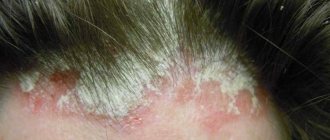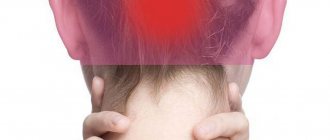- Published by: Laima Jansons
Complaints of headache occur in almost any pathology and can vary depending on the location and nature of the manifestation (burning, pressing, cutting, pulsating, etc.), duration, causes and many other parameters. Burning pain in the head most often develops due to cardiovascular or neurological pathology , less often the state of the endocrine system plays a role.
Photo 1. Headache cannot be ignored. Source: Flickr (C. Michael's Photography)
Causes of a burning sensation in the head
Burning pains often occur for various reasons; oddly enough, they have nothing to do with the head itself, but are most often caused by problems that are located in completely different areas, for example, with the spine or the cardiovascular system. The endocrine system also often lets you know about problems through burning pain localized in the head.
Cervical osteochondrosis
With osteochondrosis, pain can occur as a result of two parallel developing processes:
- Compression of the spinal nerves;
- Partial compression of the vertebral artery.
In sum, these two factors lead to disruption of blood supply and innervation, which is felt as burning, pressing pain . Most often they are diffuse in nature and spread over the occipital, temporal, and parietal regions.
Arterial hypertension
Hypertension and its complications are the most common disease among people over 40 years of age. For several decades, it has been a leading cause of death worldwide.
When pressure increases, especially during a hypertensive crisis, one of the main symptoms is tinnitus, pulsation and burning pain in the temporal, occipital, parietal, and frontal regions. Also, high blood pressure may be accompanied by a feeling of midges in front of the eyes, dizziness, nausea, vomiting, and loss of consciousness. Such conditions require immediate help , since they can provoke the development of a heart attack or stroke even in young people.
Vegetovascular dystonia
VSD is a disruption of the activity of the part of the nervous system responsible for the activity of internal organs, blood vessels, and glands. Headaches in this pathology develop as a result of dysregulation of the tone of small and medium-sized vessels . This can lead to excessive filling of the vascular bed of the meninges, spasm of individual vessels, and changes in blood pressure. Attacks of VSD are often combined with pallor or redness of the skin, the appearance of perspiration, nausea, and tinnitus.
Hormonal imbalance
Burning pains can bother women during the premenopausal period , when the hormone-producing function of the gonads gradually fades away and a significant restructuring of the body occurs. Pain syndrome is an integral part of the so-called. hot flashes, during which a woman may feel hot, cold, blurred vision and a number of other symptoms.
Photo 2. During menopause, women may experience headaches. Source: Flickr (Rima Nurmala).
Wrong lifestyle
The modern pace of life involves being under constant stress. Lack of sleep, lack of a proper meal schedule, and bad habits affect the state of the nervous system, which leads to the development of neuralgia, migraines, and cluster pain . In such a case, a burning sensation in the head can spread only to one half of the skull, occupy symmetrical areas, or cover like a hoop.
Such conditions can lead to a reflex rise in blood pressure, which will only worsen the general condition.
Note! A burning sensation in the head can also be a sign of glaucoma. During an acute attack, there is always an increase in blood pressure, which often contributes to the erroneous diagnosis of a hypertensive crisis and the prescription of incorrect treatment. Incorrect treatment of an acute attack of glaucoma can contribute to vision loss.
Treatment of headaches and facial flushing
To treat facial flushing and headaches, it is important to understand what disorders cause these symptoms. Physiological hyperemia goes away on its own and does not require therapy. For various diseases that cause poor circulation, pain, a feeling of heat and a rush of blood to the face, the following treatment methods can be prescribed:
- means for improving blood circulation, normalizing vascular tone;
- drugs to reduce blood pressure and maintain it within normal limits;
- blood thinners and prevent blood clots;
- specific painkillers for migraines;
- sedatives to correct the psycho-emotional state;
- physiotherapy, including balneotherapy and exposure to low-frequency electric current.
Doctors at the Clinical Institute of the Brain are experienced specialists in a narrow and broad profile. Based on diagnostic data, they will prescribe an effective treatment regimen that will get rid of the cause of pain and reduce the manifestations of the disease.
Nature of pain and accompanying symptoms
Burning, burning pain in the area of the brain or facial skull is almost always combined with other symptoms . The most common ones are:
- Dizziness;
- Noise in ears;
- Feeling of midges before eyes;
- Increased blood pressure;
- Nausea;
- Pallor or redness of the skin.
Various combinations of these manifestations, together with the pain symptom, its location and duration, create a clinical picture of a certain pathology.
Prevention methods
Timely prevention will not only avoid headaches and flushing of the face, but also preserve the health of blood vessels. Doctors recommend following simple rules every day that will bring overall benefits to the body:
- choose simple foods for your daily diet, avoid fatty foods and sweets, baked goods, marinades and large amounts of salt;
- do exercises in the fresh air - walking and morning exercises are suitable to maintain vascular tone;
- get rid of excess weight - it forces the heart and blood vessels to work harder even in everyday life;
- undergo annual preventive examinations, which include electrocardiography and blood tests.
The Clinical Brain Institute treats and diagnoses diseases that include headaches, fever and flushing, as well as additional symptoms. Doctors will help establish an accurate diagnosis and select a treatment regimen. However, its effectiveness will depend, among other things, on compliance with all recommendations at home. It is important not only to take medications on schedule, but also to pay attention to proper nutrition, adequate physical activity and daily routine.
Clinical Brain Institute Rating: 5/5 — 1 votes
Share article on social networks
Diagnosis of pathology
To determine the causes of a burning sensation in the head, the diagnostic process always begins with measuring blood pressure , since its increase is the most likely and common cause of this condition. In the future, consultation with a neurologist, endocrinologist and ophthalmologist is possible .
For diagnostic purposes, the following studies can be performed:
- X-ray of the cervical spine in two projections;
- Measuring intraocular pressure;
- Doppler examination of neck vessels;
- Determination of hormonal levels in women;
- MRI of the head and neck area.
What tests should I take?
To determine the reason why the head is warm, you need to conduct a series of diagnostic studies. The examination is carried out by a neurologist. During the diagnostic process, consultations with an ENT specialist, psychotherapist, therapist, ophthalmologist, neurosurgeon, etc. may be required.
The table presents the main methods that help to establish the cause and relieve the feeling that the forehead is burning:
| Analysis/research | Description |
| General and biochemical blood tests | They help assess the patient’s general condition and detect chronic diseases. |
| Electroencephalography (EEG) | Registers natural electrical discharges of the brain and displays them in the form of a graph. Allows you to exclude epilepsy and evaluate brain function. |
| Echoencephalopathy (EchoES) | The method is based on the Doppler effect (ultrasound). Allows you to identify large formations. |
| 24-hour blood pressure monitoring (ABPM). | Detects arterial hypertension. Involves measuring blood pressure over 24 hours and calculating average values. |
| Magnetic resonance imaging (MRI) | Detects vascular diseases and small tumors. |
Homeopathic treatment for symptom relief
The use of homeopathic medicines is appropriate in cases where emergency medical care is not required, such as in the case of a hypertensive crisis or an attack of glaucoma. The use of this group of drugs is appropriate for VSD, manifestations of menopause in women, and chronic stress.
- Acidum nitricum - indicated for pain in the head of a shingles nature;
- Phosphorus (Phosphorus) – helps with a burning sensation in the head with a feeling of a rush, due to prolonged stress;
- Ratania peruviana - used in case of pain of a pressing and burning nature;
- Xanthoxylon americanum - used for burning sensation in several areas of the head, flashing of midges before the eyes;
- Pulsatilla pratensis - indicated for any headaches due to overexertion, fatigue, stress.
Treatment of hot flashes
Drug therapy is aimed at eliminating the cause of hot flashes and is prescribed only after an accurate diagnosis has been established, taking into account all individual aspects. For example, if hot flashes are caused by an overactive thyroid gland, a drug will be prescribed that suppresses the production of the hormone. If a feeling of heat is a harbinger of menopause, estrogen or, if there are contraindications, special non-hormonal therapy may be prescribed. In cases where hot flashes occur as a result of various external and physical factors (being in a stuffy room, intense exercise, stress, eating spicy food, alcohol, etc.), it is enough to eliminate these causes and normalize your daily lifestyle.
Physiology of alopecia associated with burning of the epidermis of the head
Typically, permanent hair loss occurs without any significant symptoms. However, if the process of baldness is accompanied by unpleasant feelings of itching, burning, pain, rash or flaking, then the cause lies in the scalp. After all, it is here in the zone of the deep dermis that tactile receptors are located, which are responsible for the sense of touch.
They can be affected by both external factors such as tight hairstyles, skin diseases or chemical burns after hair coloring, and internal factors. The most likely areas where the burning sensation is initially most felt and hair loss manifests itself are on:
- crown;
- Frontal region;
- Temples.









